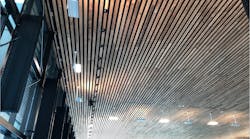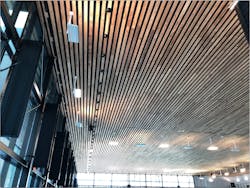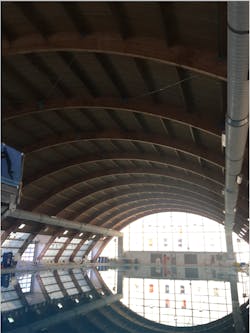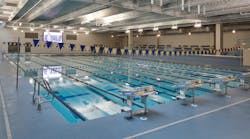Latest from Humidity Control
By RALPH KITTLER, P.E., Dehumidified Air Solutions, Montreal QC
The use of exposed wood has gained in popularity with indoor pool designers of late, for many good reasons.
It’s a modern and attractive-looking material that can easily set a facility apart. They can even contribute LEED® points to a facility due to wood’s renewable nature and its carbon footprint benefits. Trees absorb carbon over their lifetime — in fact, 50 percent of their dry weight is because of carbon. When trees get older and decay, they release their stored carbon into the atmosphere.
But, cutting them down and using them in buildings prevents the carbon from being released for at least the lifetime of the building; longer if it’s reclaimed when the building is retired. Plus, wood materials require less energy and emissions to provide.
- Read Kittler's recent cover story on a similar project at Queens University in North Carolina.
“The production and processing of wood uses much less energy... than most other building materials, giving wood products a significantly lower carbon footprint,” says Make It Wood, an Australian organization that advocates for using wood as a sustainable building material. “As a result, wood can be used as a low-emission substitute for materials that require larger amounts of fossil fuels to be produced.” Generally, using 35 cubic feet of wood, instead of the same amount of brick or concrete, can save about 1.1 U.S. tons of CO2, according to the group.
It's even not that susceptible to moisture damage, as wood can actually absorb and release water vapor without losing structural integrity, according to the Canadian Wood Council.
But while clever use of wood is a slam-dunk to get the design team some good publicity, there are some precautions that must be followed to ensure a long lifespan. The same design rules that apply to all natatoriums need to be followed when wood is used. The area needs to be conditioned by a dehumidifier to avoid any condensation and to keep the space at 50 to 60 percent RH. Additionally, the building envelope needs a continuous and unbroken vapor retarder, on the warm side of the envelope dew point, to ensure moisture does not travel through it and condense within the structure.
The Western Wood Products Association says that wood cannot become moldy until its moisture content reaches or exceeds 20 percent. The Wood Handbook, published by the United States Forest Service’s laboratory, shows that wood would never have a moisture content that high unless RH is at least 90 percent, at any temperature. So, following the standard ASHRAE design principles for pools will ensure the wood does not decay.
The designer should get information from the wood supplier regarding what RH level will ensure the wood remains pristine; most likely they will call for 50 percent RH. While wood would not become moldy, do keep in mind it will expand and contract as it absorbs and releases moisture, so the structure design needs to account for that.
Pay Attention to Airflow Design
Whether you are using exposed wood or not, one of the most important issues a designer must deal with when it comes to indoor pools is the airflow pattern. The goal is to get good air that comes out of the dehumidifier to where it needs to go — the “breathing zone” where patrons are, plus any special concern areas such as walls or windows that are likely to get cold.
The overall airflow pattern needs to ensure there are no areas of stagnation in areas where people will be. The priority should be to ensure the air within the breathing zone is being turned over, simply for the purposes of occupant health and comfort. It’s not necessary that airflow be directed at any and all wood present in a natatorium, but the goal should be to keep the wood dry. Condensation on wood is just as unacceptable as condensation on a window or door.
A great example of how wood can help make a successful facility is the new Desjardins Sports Complex in Rimouski, QC (above). Opened in 2019, it’s a modern building in every sense of the word. From its highly-efficient Dectron dehumidification system to the breathtaking mix of wood elements and glass-curtain walls, the structure brings both world-class design and facilities to this small city of about 50,000 in eastern Quebec.
The air distribution design in the Desjardins complex is very well-executed. The project engineer and general contractor, Stantec, integrated the ducts into the cedar wood ceiling, with air nozzles projecting slightly from the surface to direct air into the breathing zone and along windows.
Another use of wood can be found in the combat training pool at the Marine Corps Air Station in Cherry Point, NC (at left). The pool is used for water training for combat troops and uses an arched wood ceiling design. Ducts run along the ceiling on either sides of the natatorium, providing ample diffusion of supply air with some openings pointed up along the ceiling and others directing flow down into the breathing zone. The Cherry Point training pool also demonstrates the importance of using air diffusers with sufficient velocity; this makes sure the openings can “throw” the air far enough.
As the photos in this article show, there’s lots of flexibility in how you use wood in a natatorium. It can be both a beautiful and sensible design element if implemented properly.
Ralph Kittler is vice president at Dehumidified Air Solutions — a manufacturer of humidity and temperature control equipment. He’s had more than three decades of experience in indoor pool design and dehumidification and is the revisor responsible for Chapter 25 (Mechanical Dehumidifiers) and Chapter 6 (Indoor Swimming Pools) in the ASHRAE Handbooks.
He also was an ASHRAE Distinguished lecturer for 12 years on indoor pool design. He can be reached at [email protected].












